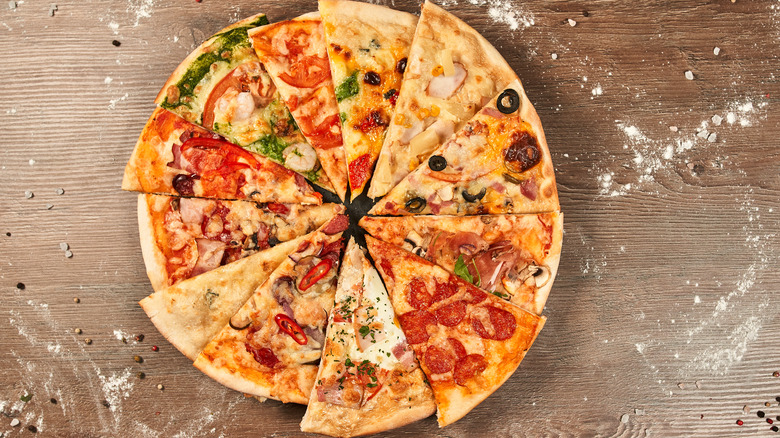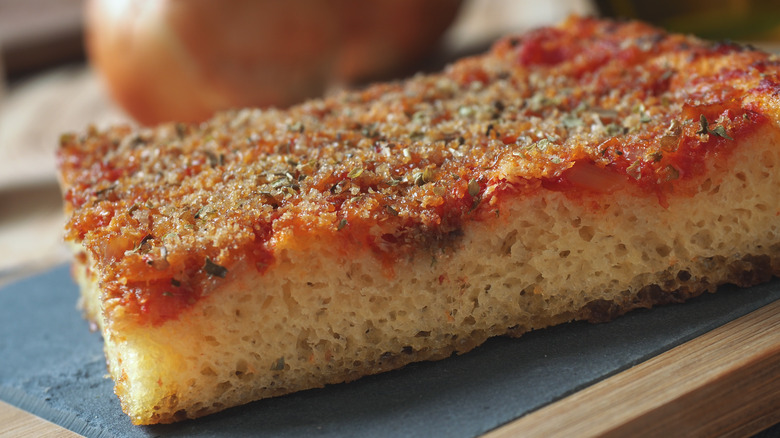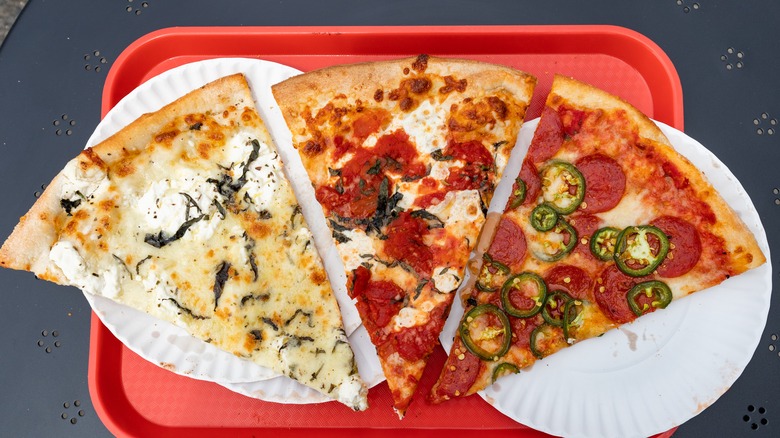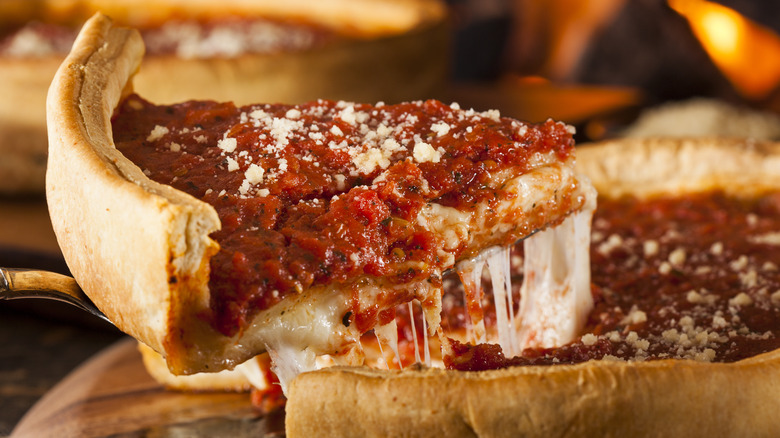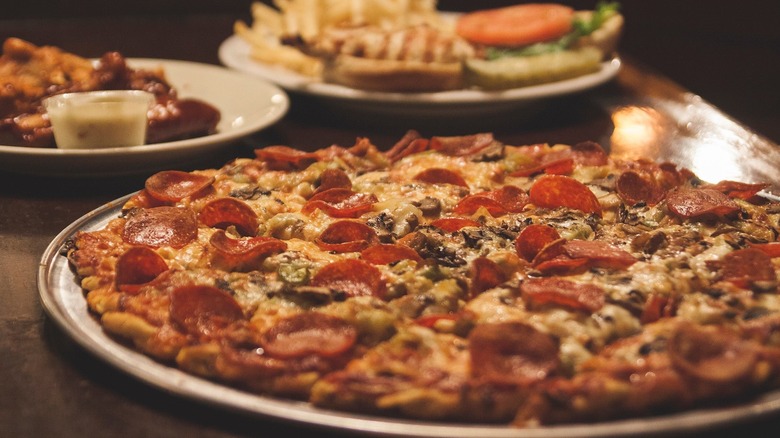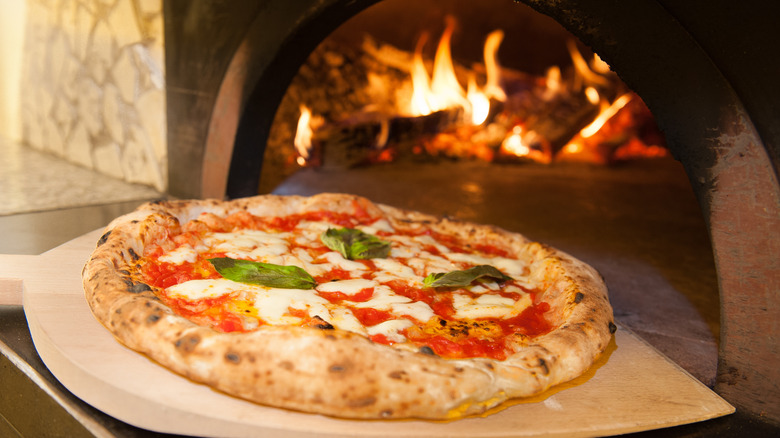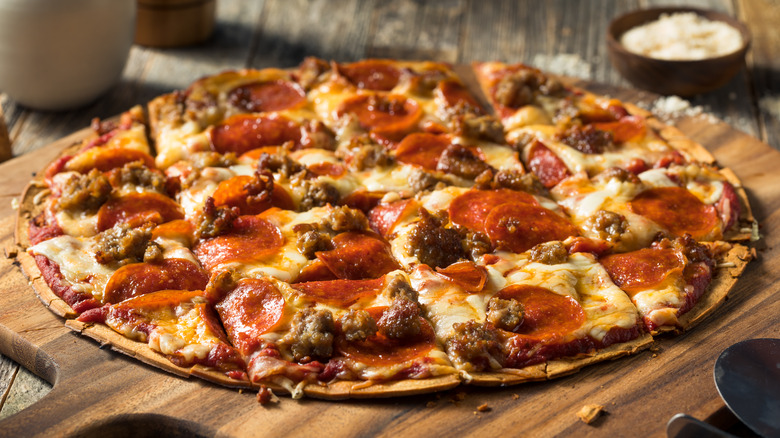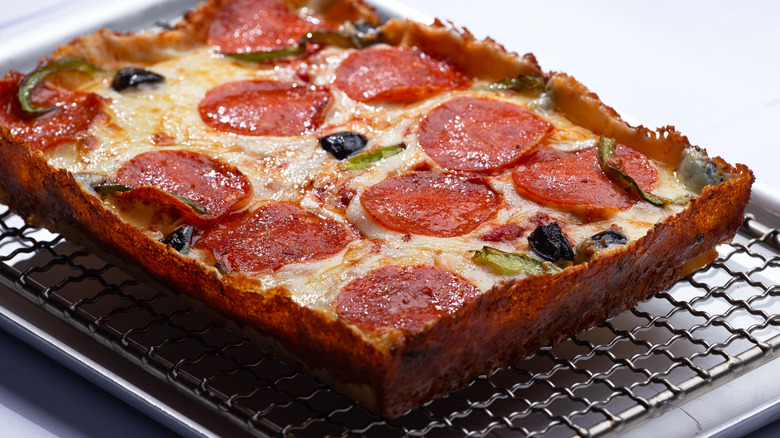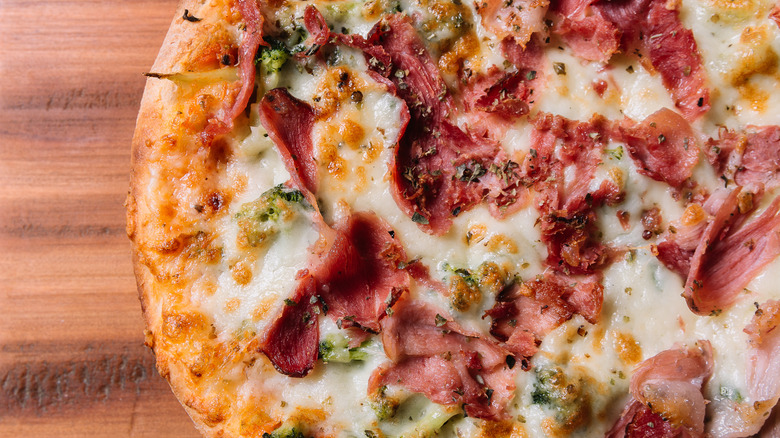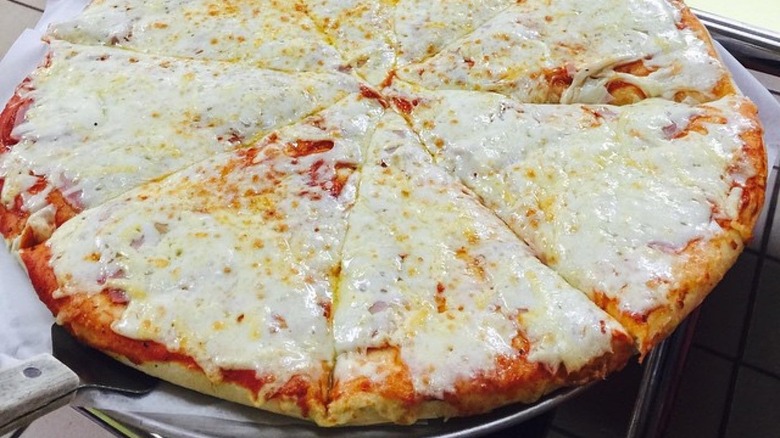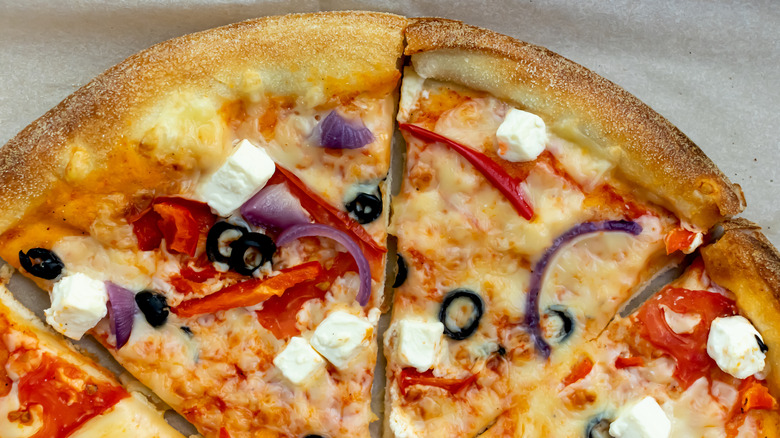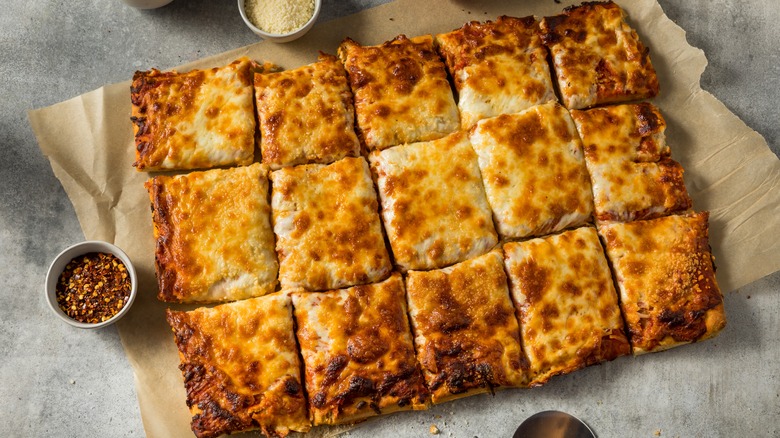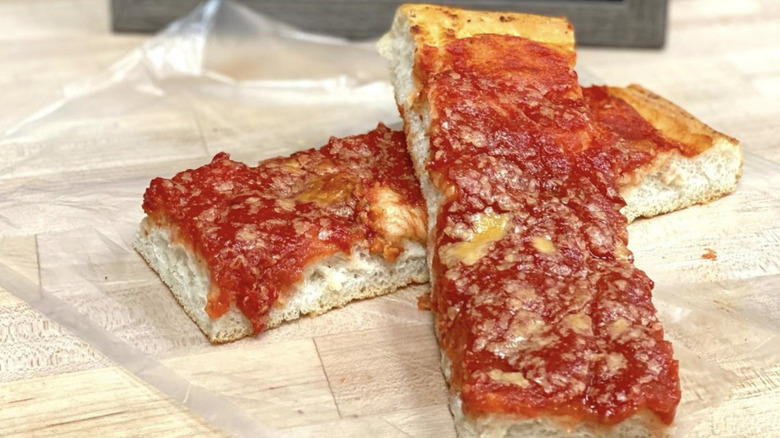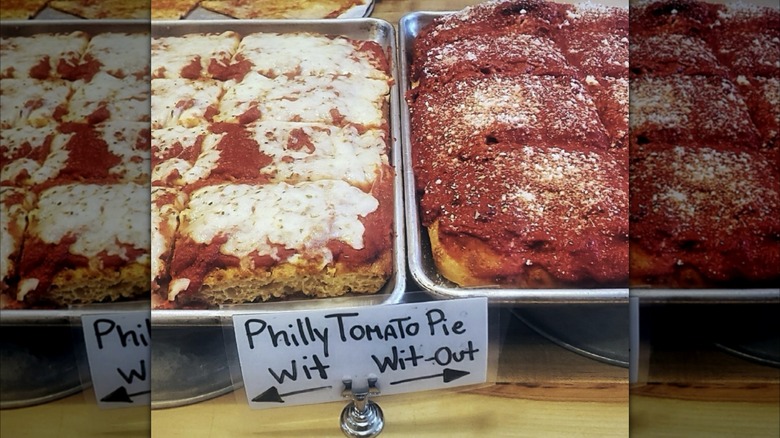19 Popular Types Of Pizza And What Makes Them Different
The truth is pizza isn't so much a food as an entire culinary category, ranging from the two-dollar frozen stuff you snag at the grocery store to ultra-expensive pies at a fancy, sit-down restaurant. That's not to say that pizza has become a commodity, exactly. It's more that its origins and different adaptations have made pizza mean completely different things depending on the style.
Looking at those pizza styles is as much an education in history as it is in food. A pizza in St. Louis is different from a pizza in New York, Boston, or Detroit, oftentimes dramatically so. Though pizza is beloved in every state across the U.S., it varies a lot. Moreover, all of those styles owe their uniqueness to the immigrant populations who introduced them. So, from the stuff straight from Naples to the crazy creations coming out of California, here's a look at some of the most popular pizza styles and what makes them all so different.
1. New York style pizza
Probably the most common style of pizza in America — well, other than "frozen," that is — is the pizza you see sitting in pizza shop windows for uncomfortably long amounts of time as you walk through New York City. And generally, this is the style you're getting when your body demands a slice at 3 a.m. New York-style pizza derives from the old, Neapolitan-American style that first came to New York with Italian immigrants in the early 20th century. But rather than being baked in ovens heated by coal, New York style is made in gas ovens.
New York-style pies typically have a thinner crust, with lots of low-moisture mozzarella cheese piled on top. They're prepared as big, flat pies — typically 18 inches or more — and sold as whole pies or slices. The cheese goes almost all the way to the edge of the crust, with an inch or so of dough left to handle the slice while eating. You'll find it in slice shops and pizzerias not only in New York but, because of its widespread popularity, in pretty much every city in America and much of the rest of the world.
2. Sicilian style pizza
Roll up to a pizza shop at some ungodly hour and, sitting next to the big triangles of thin-crust NYC style heaven, you will often also see a square, deep-dish slice that no one in your group ever seems to order. These mysterious alternatives are likely none other than Sicilian pizza. This variation of pizza offers up a square slice baked in a deep dish, with a far thicker crust and a lot more chewiness than its flatter cousin. The pies did in fact originate in Sicily. But they were invented in bakeries rather than pizza shops.
The slices sold in the Sicilian bakeries, known as sfinciuni, were a far more complex creation than the crust-sauce-cheese slices you see in American pizzerias. They were typically topped with an anchovy and tomato sauce, as well as an array of onions and bread crumbs sprinkled on top. The version we've come to know in the U.S. is a result of Neapolitans and Sicilians living in such close proximity in New York City. Their pizza styles intermixed, much like the people.
3. Roman style pizza
As you may have already guessed, you can simply name a city in Italy and it probably has its own pizza style. But the ones we've become most accustomed to in the U.S. come from Naples (Neapolitan), Sicily (Sicilian), and, to a much lesser extent, Rome. This square slice style isn't typically found in corner pizzerias or sit-down restaurants, but rather in specific Roman pizza shops. It's also known as pizza al metro or "pizza by the meter." It can also be alternately known as pizza al taglio or "pizza by the cut." So, why the interesting names?
Roman-style pizza is most traditionally cooked as a long, rectangular pie with a thin crust, lots of sauce, and minimal, if any, cheese. And unlike other styles of pizza, where slices are more or less uniform, Roman pizza is served by the measure. That is, you specify how much of that rectangular pie you want a pizzeria worker to cut off, and they charge you accordingly. That way, you can still tell people, "I only had one slice," ... even if it was two feet long.
4. Brooklyn style pizza
Back in 2006, Domino's Pizza caused quite the kerfuffle in the pizza world when it introduced its "Brooklyn Style" pizza. The collective eye-rolling led The New York Times to take one of the said pies into a Coney Island pizza shop, attempting to determine whether it even remotely resembled pizzas one could buy in actual Brooklyn. The verdict was an emphatic no. Which left America with a pretty daunting question: What, exactly, is Brooklyn-style pizza?
Brooklyn-style pies aren't all that different from New York style. Some, like Bacinos, might argue that the cheese is a mozzarella and provolone blend rather than a topping made entirely of part-skim mozzarella. Larger toppings are also a frequently cited feature of Brooklyn-style pizzas, as are the slightly larger pies. There is a contingency, like the Booklynites interviewed by The New York Times, who believe the style was developed more as Domino's marketing term and less of a proper pizza style. So, the current, rather frustrating verdict is simply that Brooklyn pizza is really hard to pin down. But no matter your criteria, it's always delicious. It's pizza, after all.
5. Chicago deep dish pizza
Much like with its baseball teams, Chicago also has two distinct styles of pizza. And though the rivalry isn't quite as divisive as that between the Cubs and the White Sox, people in the Windy City definitely have their opinions on pizza, too. The unique deep-dish variety is the one most around the country associate with Chicago, the buttery, almost pastry-like crusts topped with heart-stopping amounts of cheese. But, despite the crowds that you might see at Lou Malnati's and Giordano's on any given Friday night, the deep-dish style of Chicago pizza isn't exactly something most locals can handle every day.
Deep-dish pizza happens when you spread a pie crust over a deep, oil-slicked pan. Then, you fill the said crust with layers of mozzarella cheese and other toppings before capping the whole thing off with crushed tomatoes and, if you hate your cardiologist, some Italian sausage. It's also a bit of a tourist attraction. Kind of like The Space Needle, Ocean Drive, and the Hollywood Walk of Fame, Chicago deep-dish pizza is often something locals will only experience when they have friends in town. This is probably good for the city's collective health: Even a small whole pie from Giordano's clocks in at over 2,500 calories!
6. Chicago thin crust or tavern style pizza
The far more frequent choice for discerning Chicagoans is the thin crust or tavern-style pizza. Bon Appétit went so far as to call it "Chicago's real signature pizza," citing everyone from local food authors to pizza tour guides who claim this is the style locals identify with most. Tavern-style pizza dates back to around World War 2 and became popular in the corner watering holes that working-class Chicagoans frequented in the decades that followed.
The pie is circular and has a thin crust that's rolled instead of tossed, then baked to have a cracker-crisp crust that's known to cut the roof of an unsuspecting eater's mouth. It's topped with sauce and cheese and then summarily cut into haphazardly sized squares. Bon Appétit offers up a couple of theories as to why this pizza style is offered up in rectangle form. For one, square slices made the pizzas easier to share at a bar. They also presented bites small enough to feed kids without much waste. Either way, it's become the true Chicagoan's Chicago style, even if few outside the city really know much about it.
7. Neapolitan pizza
As the gourmet pizza restaurant has become a staple of the food scene in pretty much every American city, by and large people have become well educated in Neapolitan-style pies. We can recognize Neapolitan-style pizzas by the char out the outside of the crispy crust, as well as the thin, sometimes soggy center of the pizza, and the fresh mozzarella cheese on top. And while that could definitely constitute something in the realm of a Neapolitan-style pizza, the personality trait of this unique style actually runs far deeper.
According to D Magazine, there are five main factors to look for when spotting a true Neapolitan-style pizza. First, the dough is made from double zero flour imported from Naples, then kneaded from the center out to create the trademark fluffy crust on the perimeter. Chefs evenly distribute cheese over the entirety of the dough, while tomatoes are peeled and crushed by hand for the sauce. They then cook the pies for only about 60 to 90 seconds in a special, ultra-hot wood-burning oven. Finally, the finished Neapolitan pie should be colorful, with reds, greens, and whites that don't require a filter for your Instagram masterpiece.
8. St. Louis style pizza
Perhaps the most polarizing style of pizza in America comes from the dead center of the country, in Missouri. There, the cracker-thin St. Louis-style pizza has won many hard-core devotees as it has generated surprised and sometimes even disgusted detractors. According to Feast, Jimmy Kimmel is a notorious hater of Imo's, the quintessential spot for St. Louis-style pizza, going so far as to grill St. Louisan guests on his show about their opinions. But it also has plenty of fans. In the same article, Feast quotes St. Louis native Jon Hamm telling Kimmel the stuff "tastes like 11 World Series victories." So, clearly, this style has its fans.
It's hard to say why, exactly, St. Louis style pizza divides people like no other pizza. It's a fairly simple concept — a cracker-like crust topped with sweet, oregano-heavy sauce and gooey Provel cheese that's then cut into squares. It's by no means gourmet but is at least always affordable. Plus, if you were a fan of crispy frozen pizzas as a kid, St. Louis style should taste just like home. You'll rarely find it outside the 314, but if you're in town it's a must-try.
9. Buffalo style pizza
Though Buffalo has become synonymous with wings, and those who know Nickel City cuisine might also mention beef on weck, this city on the shores of Lake Erie also has a distinctive style of pizza. And it's just as filling and comforting as the other famous foods Buffalo has given to America.
Though it's not particularly common outside Western New York, Buffalo-style pizza starts with a carb-bomb of a crust, a thick, oily creation that is more similar to a chewy bread than it is to a pizza crust. It's then topped with a mild red sauce and epic amounts of cheese. And while you could stop there, in order to truly experience Buffalo-style, the pizza must be ordered with pepperoni. More specifically, the curled up, slightly charred pepperonis that have little pools of grease in the middle. Biting into one is like a sensory trip to a Buffalo Bills tailgate, minus jumping into the tables.
10. Detroit style pizza
No city can intertwine its most iconic industry with one of its most iconic foods quite like Detroit. The history of Detroit-style pizza all began when Detroit tavern owner Gus Guerra used a couple of repurposed steel utility trays from a nearby auto factory to make his take on a Sicilian pizza. The result is a deep-dish pie unlike any other in America, cooked in the pizza equivalent of a cast-iron skillet that's as much an ingredient as the thick crust or the Wisconsin cheese.
While you might see "Detroit-style" pizzas on a lot of menus around America, the true stuff must start with a steel pan that's been coated in oil. The thick Sicilian-style crust is then placed in the pan, topped with sauce, toppings, and nearly uncomfortable amounts of cheese drizzled all the way to the edge, followed by yet more toppings and red sauce. The assemblage is then cooked until the cheese melts and caramelizes over the sides of the pan, giving a delicious, crispy, slightly burnt cheese texture to complement the soft, fluffy pie inside. It's the kind of cold weather treat you can imagine exhausted auto workers reveling in during the city's industrial heyday. It's still pretty delicious today.
11. California style pizza
California-style pizza may be the only style that's known more as a restaurant than a specific style of pizza, as nearly anyone who's spent some time at a California Pizza Kitchen can tell you. However, it's hard to pin down anything as specifically Californian, given how many people live in the state. But that's kind of the idea. California pizza is all about diverse creations on top of a fairly standard base.
The style dates back to around 1980 when Bay Area restaurateurs Ed LaDou and Alice Waters were trying all kinds of crazy stuff atop New York-style crusts. LaDou went on to mentor Wolfgang Puck, who brought ingredients like potatoes, artichoke hearts, and green salads to the pizza world. LaDou also had a big hand in developing the menu for California Pizza Kitchen, which made barbecue chicken pizza almost as normal as pepperoni. And as California has become known for its own weird brand of creativity and occasional genius, so is its eclectic, daring pizza style. Which, while hard to define, is surely never, ever dull.
12. Miami or Cuban style pizza
Surprisingly enough, Cuban-style pizza doesn't really come from Cuba. It's traced more accurately to Cuban-Americans who developed the style in nearby Miami, Florida. Specifically, it can be traced to Rey Pizza, a Miami chain with a number of locations that are open 24 hours a day. And late at night is really the best time for eating this unique style of pizza.
The pizza itself is fairly simple. It's a thick, doughy crust not unlike Sicilian or Detroit-style pizzas. But here, Cuban-style is topped with a very thin layer of sauce that leaves the pizza almost dry. Then it's graced with toppings, followed by a layer of mozzarella and gouda cheese. While it's on many a list of must-eat foods in Miami, it's not up there with croquetas or chicken chop chop. But if you want to try something that'll give you a little local cred, a late-night stop at Rey Pizza will definitely add something to your vacation.
13. Calabrian style pizza
Calabrian pizza is a style not seen often on American menus. That's because, much like Calabria is not far from Naples, so is its pie not all that far from the Neapolitan style. The differences between Calabrian and Neopolitan-style pizzas are, at least at first glance, hard to see. Both have little bits of black char on their brown crusts. Both use wheat flour. Both are topped with mozzarella. Why not call it the same and move on?
But Calabrian pizza is thinner and crisper than Neapolitan, mostly because it's rolled instead of tossed and cooked a lot longer to achieve said crispiness. The crust also has olive oil in it, which Neapolitan does not, and you won't find the puffiness or bubbles in the crust of a Calabrian pizza. Think of it as a flatter, crisper take on Neapolitan pies and you're pretty close to nailing it. The differences are small, but side by side they're very apparent indeed.
14. New Haven style pizza
If you ordered your pizza from a shop advertising New Haven-style pizza, for the sanity of the poor kid answering the phone, please be sure to read this before calling to complain your pizza is burnt. New Haven-style pizza, a coal-fired variety hailing from the home of Yale University in Connecticut, is supposed to be well done. Like, really well done. Or, "charred" as New Havenites would call it. Locally, New Haven-style pizza is called "apizza," a remnant from the heavily-accented Neapolitan immigrants who settled around Wooster Square.
Their initial style of pies was made with long-fermented dough that was proofed overnight, then baked in a coal oven with nothing but tomato sauce. Seriously, that's it. This is why, even today, you need to specifically ask for cheese, or "mootz," on your New Haven pie if you want any at all. The coal-charred pizzas are topped with a sharp red sauce but also come in a white clam variety if you're feeling adventurous. No matter what you order, just remember that apizza isn't like any other style on this list. And claiming it's "burnt" will get you more than a side-eye from anyone who knows their stuff.
15. New England or Greek style pizza
Interestingly, New England or Greek-style pizza doesn't have much at all to do with Greece, the name owes more to the Greek immigrants in New England who popularized the pizza there first. If there's one thing that defines Greek or New England-style pizza, it's olive oil. Olive oil in the crust. Olive oil on the crust. Olive oil all over the pan. Even olive oil on top of the pizza. If you're not a fan of the stuff, this is most definitely a style to be skipped. But if you are? You're in for a treat.
The generous amounts of olive oil on these thinner-crust pizzas leave it much crispier and greasier than its Neapolitan cousins. It's also typically cooked in an electric oven or brick oven, according to Greek Boston, so it doesn't get the char you find with wood-fired pies. The sauce is also a little thinner and milder than most pizza sauces, mostly because it's diluted with ... wait for it ... more olive oil. So while your waistline may suffer a touch after eating the stuff, your skin's gonna look amazing.
16. Grandma pie
The grandma pie got its start in Long Island but is now available in pizzerias around the country. At first glance, it appears similar to other rectangular pizza styles. But when you look at this pie from the side, it's easy to see that the crust is significantly thinner than a square Sicilian.
This difference is due to the grandma pie's restricted rising time. It's also baked on a cookie sheet rather than a conventional pizza pan. This choice of pan is rooted in the pie's history; it was originally created and utilized by Italian immigrants who didn't have access to the super hot wood-fired ovens that would otherwise help give the dough a quick lift. The cookie sheets allowed home cooks to adapt a pizza recipe to cook low and slow in a gas or electric oven.
Another difference between grandma pie and other pizza styles is that the grandma pie's crust is coated in olive oil before it's sauced and baked in the oven. This means that, like a Detroit-style pizza, the sides and bottoms of the pie will crisp up perfectly when the heat hits it.
There aren't any particular toppings that are part of the grandma style, but the original inspiration for the pie, pizza alla casalinga ("pizza housewife-style"), was made simply with crushed tomatoes, garlic, and Pecorino Romano or Parmesan — though you'll often see modern interpretations of the grandma pie topped with mozzarella.
17. Rhode Island style pizza
Rhode Island-style pizza is about as quintessential as a regional-style pizza can get. While New York-style pizza may focus on a cheesy pull and Detroit-style may key into a crispy, caramelized corner slice, Rhode Island-style pizza focuses on the sauce. This pizza style is often sold as strips, with a simple structure of focaccia-like dough followed by sauce and maybe a sprinkle of grated Romano on top. Another key detail about this pizza, which will likely evoke rage from pizza snobs everywhere, is that this pizza is served at room temperature — not piping hot straight out of the oven.
The origin story of this style of pizza is difficult to pinpoint. But it's said that the style began after bakeries left bread-dough-turned-pizzas on the counter for too long for customers to purchase. Since the local health department objected to leaving pies with dairy out on the counter where it could spoil, the pizzerias pulled off the cheese and started selling the strips instead.
You'd be hard-pressed to find this Ocean State pie outside state lines. But, the best thing is that Rhode Island is such a small state that you could sample every bakery and old-timey pizza shop selling these strips within the same day.
18. Boardwalk style pizza
Our next stop on our pizza journey takes us to the Jersey Shore, where boardwalks are aplenty. The first thing you notice when you order a proper boardwalk-style pie from a Jersey Shore pizzeria is the swirl of sauce on top. These boardwalk-style slices tend to be massive and thin, which bears some resemblance to the New York-style pie. However, the swirl is the key distinguishing factor that sets this pie apart from all the others.
If you find yourself stopping by the Jersey Shore to get a slice of this regional pizza style, look no further than Manco & Manco. Not only is it one of the best pizza spots on the Jersey Shore, but it's also one of the top spots to get one of these pies anywhere. Start with a plain cheese pie and add your favorite collection of toppings to the top. But we'd go so far as to say that you don't need additional toppings to distract you from how good the pizza is.
19. Philadelphia tomato pie
New Haven apizza isn't the only style with a monopoly on tomato pies. In the City of Brotherly Love, tomato pies look a whole lot different.
Instead of serving the sauce and cheese on a thin crust, Philly's pizzaiolos swap the measly crust for a thick, focaccia-like one. Philadelphia's tomato pies are also unique because they're often served cheese-less — although you can find some modern iterations that add extra umami flavor with grated cheese. The cheese was historically left off these pies because it wasn't used often by the Italian immigrants who brought the pizza style to America during the 19th and 20th centuries. The immigrant population came from the southern regions of Italy, where pizzas didn't really contain cheese, so the addition didn't catch on until much later once the pie landed in the United States' pizza-making lexicon.
Philly is the perfect city for grabbing a slice of this pie, which is often served with savory toppings like anchovies, herbs, and tomatoes. It's sweet yet simple — although it may be an acquired taste for people who prefer a cheesy bite and a thin, snappy crust.
